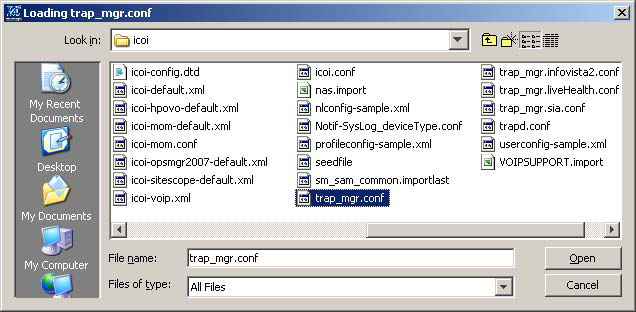The trap_mgr.conf files used to configure a TRAP-INCHARGE-OI server (SNMP Trap Adapter) may be loaded into Smarts NOTIF to replicate the standard file-based functionally. All .conf file features and options are supported. Trap_mgr.conf files can be imported into a new configuration (File > New Configuration) or an existing open configuration (File > Open Configuration...) in the Smarts NOTIF Editor.
To import a trap_mgr.conf file into a new or open configuration:
-
In the Smarts NOTIF Editor, select File > Import trap_mgr.conf.
-
The Loading trap_mgr.conf dialog box appears as shown in Loading trap_mgr.conf dialog box. Select the trap_mgr.conf file that you want to import and click Open.
Figure 1. Loading trap_mgr.conf dialog box 
The configuration from the trap_mgr.conf file is loaded into the Smarts NOTIF Editor.
Note:If the trap definitions contain MAP statements, they will not be imported. You need to manually specify a value for the EnumeratedValue option in order to obtain the Map statements. Mapping statement functionally, (trap/varbind position dependant), is replaced with true enumerated value substitutions, (EVM's in NOTIF), that require OID's for generic substitution. Aggregation definitions within trap_mgr.conf generally reference substitution names such as '$E$-$G$-$SomethingElse$,' which is undetermined within the scope of NOTIF aggregation. The user should review the trap_mgr.conf file to determine what EVM's and aggregations need to be created in NOTIF given the appropriate OID's and names.
-
In the Smarts NOTIF Editor, click File > Save Configuration or File > Save Configuration As... to save the imported configuration.
Note:When you import configuration files, they only become persistent in the Adapter Platform or SAM server when you click Save Configuration or Save Configuration As... Otherwise, the imported configuration is only in memory (non-persistent).